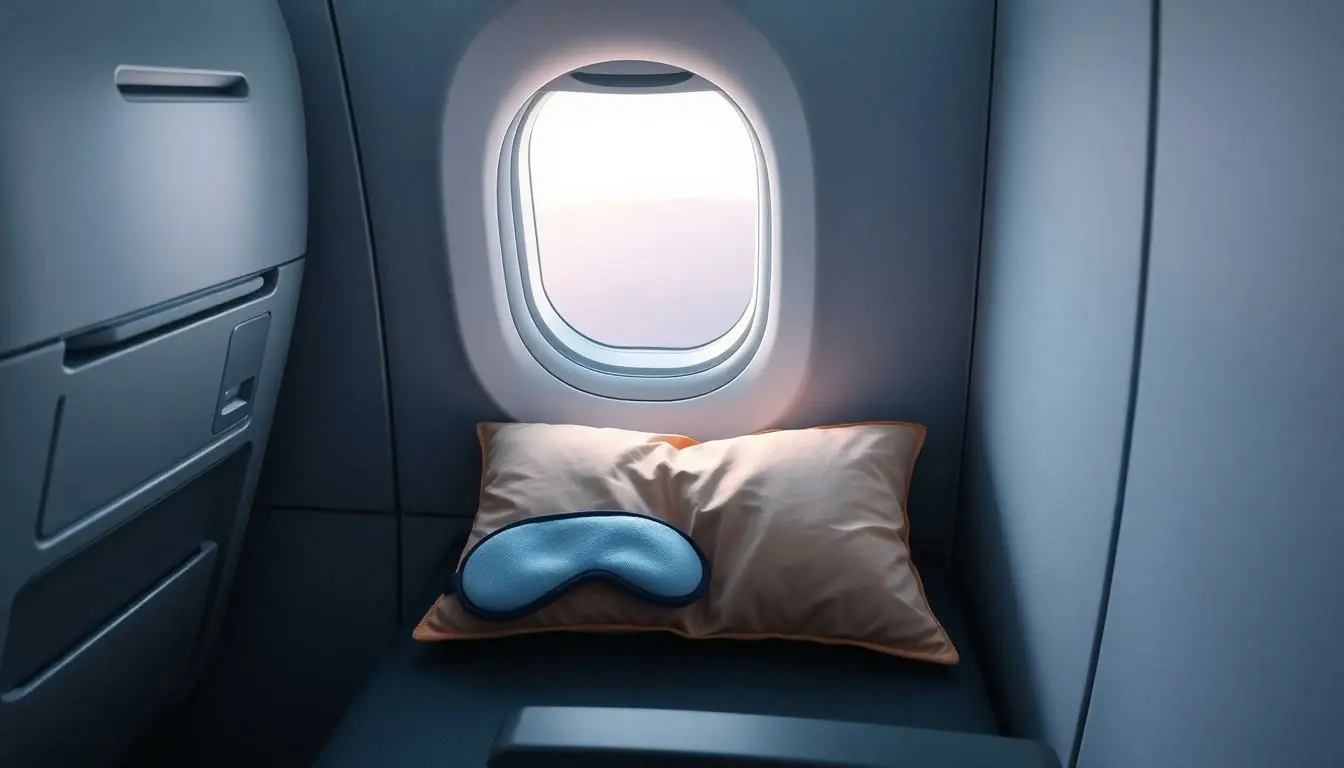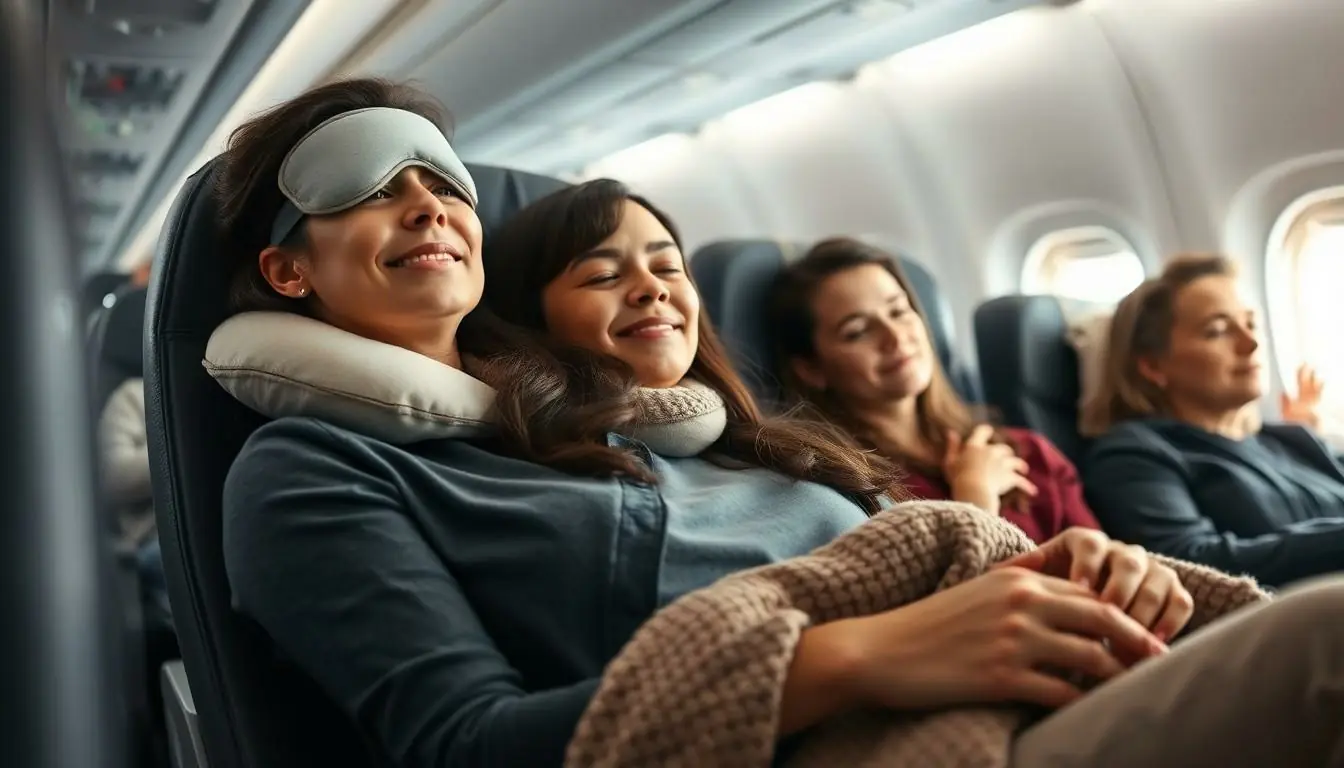Flying can feel like a game of musical chairs where the music never stops, and everyone’s fighting for the best seat. If you’ve ever found yourself wide awake while the rest of the cabin snoozes peacefully, you know how frustrating it can be. But fear not! With a few clever tips, you can turn your next flight into a cozy sleep retreat instead of an uncomfortable endurance test.
Table of Contents
ToggleImportance Of Sleep While Traveling
Sleep plays a crucial role in maintaining overall health and well-being during travel. Insufficient sleep affects mood, cognitive function, and energy levels, all of which are essential for enjoying a trip. Research indicates that lack of sleep can lead to decreased alertness and increased risk of accidents.
Quality sleep boosts the immune system, helping travelers ward off illnesses from crowded airports and shared airplanes. Travelers often experience a disruption in their circadian rhythms, making it essential to prioritize rest during flights. Furthermore, adjusting to new time zones can be challenging, and having adequate sleep eases that transition.
Sleep deprivation contributes to heightened stress and anxiety levels, which can impair the travel experience. Studies show travelers who prioritize sleep exhibit better decision-making skills and communication. They also tend to be more resilient when facing travel-related obstacles.
Napping during flights can help bridge sleep gaps caused by time zone changes or irregular travel schedules. It’s especially important for long-haul journeys, where fatigue from extended periods of wakefulness can accumulate. A rested traveler is more capable of enjoying their destination, whether it’s exploring a new city or engaging in activities.
Prioritizing sleep while traveling enhances the enjoyment of the journey and overall experience. By recognizing its importance, travelers can implement strategies that promote rest and recovery, leading to a more enjoyable and fulfilling travel adventure.
Preparing For Your Flight

Preparing for a flight involves careful considerations to enhance comfort and facilitate sleep. Implementing thoughtful strategies ensures better rest during air travel.
Choosing The Right Seat
Selecting a seat significantly impacts sleep quality. Window seats provide a solid surface to lean against and allow one to avoid disturbances from fellow passengers. Seats near the wings tend to experience less turbulence, creating a more stable environment for sleep. Passengers should consider booking extra legroom seats for added space and comfort. Avoiding seats near high-traffic areas, such as restrooms, helps reduce sleep interruptions during the flight. Opting for a seat in a quieter section of the airplane remains crucial for restful sleep.
Packing Essential Sleep Aids
Bringing sleep aids enhances the likelihood of achieving restful sleep in-flight. A travel pillow can provide neck support, promoting relaxation during the flight. Noise-canceling headphones block out unwanted sounds, ensuring a peaceful experience. An eye mask prevents light from disturbing sleep, creating an ideal dark environment. Including a lightweight blanket keeps passengers warm and cozy. Hydration is essential, so packing a reusable water bottle promotes sipping on water throughout the flight. By utilizing these aids, travelers increase their chances of sleeping better while flying.
In-Flight Strategies For Better Sleep
Travelers can implement various strategies to create a conducive sleep environment.
Creating A Comfortable Sleep Environment
Selecting the right seat significantly impacts comfort. Window seats present a stable area to lean against, minimizing distractions. Extra legroom seats often provide additional space for stretching out. Packing items like travel pillows and lightweight blankets enhances comfort during the flight. Additionally, using eye masks can block out light, promoting a sleep-friendly atmosphere. Noise-canceling headphones help drown out ambient sounds. Maintaining hydration by drinking water also prevents discomfort that can interrupt sleep.
Mindfulness And Relaxation Techniques
Incorporating mindfulness techniques can ease anxiety during flights. Focused breathing exercises reduce tension and promote relaxation. Simple practices like progressive muscle relaxation help the body relieve stress. Guided meditations via apps can enhance the relaxation experience. Listening to calming music or nature sounds supports a tranquil mindset. Visualizing serene environments can distract from the surrounding noise and movement. Utilizing these techniques allows travelers to drift into restful sleep more effectively.
Post-Flight Recovery Tips
Recovering from a flight’s impact is essential for restoring energy and well-being. Adjusting sleep patterns after arriving helps mitigate the effects of travel-related fatigue. Prioritizing hydration is critical; drinking water immediately after landing replenishes fluids lost during the flight.
Engaging in light physical activity, such as stretching or walking, promotes blood circulation. Movement reduces stiffness and helps reset the body after sitting for long periods. Consuming nutritious meals instead of heavy ones aids in regaining energy levels. Balanced meals with proteins, whole grains, and fruits support recovery.
Establishing a post-arrival sleep routine benefits overall rest. Creating a dark, quiet sleeping environment mimics conditions conducive to quality sleep. Limiting screen time before settling in also enhances the ability to fall asleep.
Taking a short nap, ideally 20 to 30 minutes, allows for a quick energy boost without disrupting nighttime sleep. If necessary, using sleep aids should be approached with caution; seeking professional advice ensures safe use.
Overall, incorporating these recovery tips assists travelers in adapting quickly to new surroundings. Focusing on hydration, nutrition, movement, and sleep habits makes for a smoother adjustment post-flight. Balancing these elements helps maintain overall health, allowing for a more enjoyable travel experience.
Traveling doesn’t have to mean sacrificing sleep. By implementing the right strategies before, during, and after a flight, travelers can transform their in-flight experience into a restful retreat. Prioritizing comfort through seat selection and packing essential sleep aids can make a significant difference.
Incorporating mindfulness techniques can further enhance relaxation, allowing for better sleep on the plane. Once the journey is over, focusing on hydration and adjusting sleep patterns ensures travelers recover quickly and maintain their energy levels.
With these tips in hand, anyone can conquer the challenges of sleeping on a plane, making every trip more enjoyable and rejuvenating.



